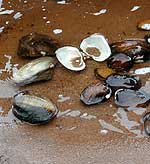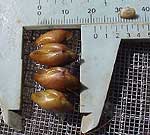By Erin Galbally
Minnesota Public Radio
May 6, 2002
Over the last century, the Army Corps of Engineers has transformed the Mississippi River. A series of locks and dams have made a reliable highway for commercial barge traffic. Many of the river's native species have suffered. None more so than the shrinking collection of fresh water mussels. The Army Corps wants to increase commercial river traffic, and the rush is on to save some species.
| |||
| |
|
||
|
|||
On an early spring morning, three boatloads of scientists fan out across the St. Croix River. Researchers dive into the chilly water searching for fresh water mussels.
There's a university researcher, representatives from the U.S. Fish and Wildlife Service, and the Minnesota and Wisconsin Departments of Natural Resources.
Its not long before the teams gather on shore with a pile of oddly-shaped mollusks. Mike Davis from the Minnesota DNR rattles off a list of names.
"Three Ridge, the Dimple Back, this one I think is a Fat Mucket, Butterfly, Fragile Paper Shell, Pink Heel Splitter."
This portion of the St. Croix is the equivalent of mussel heaven. But there are some unwelcome invaders. Zebra mussels have moved up the Mississippi River, and over the last six years they have made their way into the St. Croix. There are fewer of them here, but still, zebra mussels are beginning to undermine the native mussel population. Zebra mussels monopolize the food and oxygen that native mussels need to survive.
University of Minnesota research biologist Mark Hove and Fish and Wildlife's Nick Rowse examine another mussel. What they see defines the problem - a native mussel with a zebra mussel that's attached.
| |
|
|
|
||
"See - the zebra mussel gets attached with the Bissell threads attachment...here it is right here," the scientists explain.
Zebra mussels eventually smother their host. Without native mussels the river becomes a darker, murkier place. Mussels like the endangered Higgins Eye help filter the water. That makes it easier for fish to get around.
The shell of a Higgins Eye is golden brown, and flecked with orange and green rays. It's a species battling for survival, as more and more of the river is overcome by zebra mussels.
The DNR's Mike Davis helped pioneer a plan to revive the Higgins Eye. Biologists inject mussel larvae into host fish. The fish are put into special chicken wire cages, and the cages are then dumped in the St. Croix. The fish remain in the cages in the river until the larvae drop off and the mussels begin to mature.
Davis makes the cages in Lake City, near Lake Pepin. This section of the river is infested with zebra mussels. From the banks of Lake Pepin, Davis says relocating the native mussels is just a short-term solution.
| |
|
|
|
||
"Moving the mussels is not the answer in the long run. It's an emergency. Let's save the day before the ship sinks," Davis says. "But in the long run, operating the river as something other than a series of permanent lakes would make it much less viable habitat for the zebra mussel, and that's what we need to do at some point."
That's where the river's controversial navigation system comes in. A series of locks and dams makes commercial navigation possible, but they've forced the Mississippi to follow an unnatural course. In the late 1980s, commercial barges began to import zebra mussels to the upper Mississippi, and their numbers quickly multiplied.
The Army Corps of Engineers has studied an expansion of the locks and dams for more than a decade. Commercial interests argue the locks and dams need an upgrade. They say it's necessary to keep the country's agriculture sector competitive on a global level.
But the Corps study was discredited two years ago. An Army Corps economist accused the agency of skewing its figures to make the expansion look good.
Larry Laber manages Cenex Harvest States' port in Winona, along the Mississippi River, and doubts the navigation system will see an overhaul in his lifetime. But Laber says the need is there. The Cenex port now ships 40 million tons of corn downriver each year. Laber says that's a dramatic increase from his early days on the Mississippi.
| |
|
|
|
||
"When I came here 16 years ago, if we loaded 200 barges that was a really an accomplishment. That was a really busy year. This year we'll approach 800 barges. The size of our crew has changed very little, but the quantity is a four-fold increase," says Laber.
That means more barges transporting greater numbers of zebra mussels upstream. Zebra mussels use the barges as a form of rapid transit - they hide out in the ballast water or attach to the hulls of ships. And as a result, more zebra mussels in the upper Mississippi increase the threat to native mussels.
With that in mind, the Army Corps is funding a mussel conservation program. The agency will pay $2.5 million to create 10 mussel refuge sites spread across four states.
The Corps' Dennis Anderson oversees the mussel relocation effort. He's also in charge of zebra mussel control. Anderson says the success of both projects is intertwined, and he's hopeful the Higgins Eye will make a comeback.
"If we can develop an effective control mechanism for zebra mussels, and implement the measures necessary, not only will it return but it will be better than it was," says Anderson. "We're establishing all of these new populations, but it's all contingent on whether we control zebra mussels."
A plan to do just that may take at least 10 more years to get up and running. And Anderson concedes - even then there's no guarantee zebra mussels will disappear.
| |
|
|
|
||
In the meantime, scientists like Mark Hove at the University of Minnesota are busy in the lab, working on native mussel propagation.
"These are the stars of the lab. These are the mama mussels, the female mussels that are brewing their young."
Fish implanted with Higgins Eye larvae swim back and forth in a tank nearby. Hove has found that the Higgins Eye seems to like typical river fish as hosts - fish like the small mouth bass. Hove says the importance of mussels can't be underestimated.
"If we take these large mussels out of the river, it might be analogous to what would happen if we took the giraffes, rhinoceros, elephants, and zebras out of the Serengeti," Hove says. "What would happen? It's not clear. It would certainly be different. And what's going to happen out in the Mississippi if we remove these animals?"
Scientists have the same question about the other species along the Mississippi. For thousands of years, Tundra swans have migrated along the river corridor. Now they have a harder time finding the feeding areas they need to survive. The populations of ring-necked ducks and canvasbacks are rapidly declining. And one-third of the river's fish species are listed on state or federal watch lists.
As people debate the wisdom of an expanded lock and dam system, these species are on the line. It will take compromises on all sides of the issue to ensure creatures like the Higgins Eye mussel can survive.
More Information




